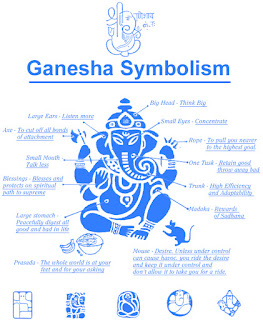Storybook Favorites
The first storybook that caught my eye was titled “Ganesha:How It All Began.” I've heard of Ganesha and seen the deity's iconography, but I never knew of his origin. As a result, I decided to check out the storybook. The introduction was concise and accessible while providing in-depth information about Ganesha. Growing up, I learned about the deity and his characteristics, but I never knew of the symbolic aspects of Ganesha. The diagram in the introduction demonstrated how Ganesha’s portrayal reflects Hinduism’s spiritual beliefs. For example, Ganesha’s axe symbolizes the act of cutting off all bonds of attachment, which parallels the lifestyle of Hindu ascetics. After reading through the introduction, I navigated through the storybook; the design choice avoided distractions and allowed the content to be the main focus.
A diagram detailing the symbolism of Ganesha. Source: Wikipedia
The second storybook I was interested in was titled “Krishna:Lord of Infinity.” The inclusion of infinity within the title piqued my interest, and the home page design drew me in; the banner image was intense but peaceful, paralleling Lord Krishna’s role as a deity. The introduction offered more information about Krishna and employed an authoritative tone to assert Krishna as the Supreme Personality of Godhead. Furthermore, the introduction contextualized Krishna through his various perspectives. Whether he’s a child killing demons, a cowherd boy, a king, or a god, Krishna’s life and his narratives evolve over time.
The third storybook was titled “Tales of Hanuman.” Like the previous storybook, the design of the home page made me interested in reading more about Hanuman. The colorful image of Hanuman chasing the sun made the storybook stand out, and the layout made all content easily accessible. The introduction described Hanuman as a right-hand man and referenced his legendary feats, but the general summarization of the specific deity was also found in the other two storybooks. I found this introduction to be unique through its explanation of how these narratives were told. The explanation of Talas, its role in the delivery of the Hanuman Chalisa, and its similarities and differences to Western music made the introduction stand out. Rather than simply summarizing Hanuman as a character, this introduction added another dimension by exploring how the deity’s story is told.




Comments
Post a Comment